Over the past three months, we’ve provided rules and guidelines for feeding a homemade dog food diet, but getting started can still seem overwhelming. The recent pet food recallshave left many people wanting to switch their dogs quickly to a homemade diet, at least short-term. Despite their fears about commercial pet food products, however, many have hesitated to start feeding a home-prepared diet, concerned that their diet would be less than perfect.
Our advice? Don’t worry about achieving the ideal diet from day one. Adult dogs will do fine on a limited diet for two or three months. If you want to continue to feed a homemade diet for longer than that, or if you are feeding a puppy, it becomes more important to ensure that you are feeding a wide variety of different foods in appropriate proportions to meet all nutritional needs. As you become more experienced with shopping for and preparing your dog’s food, and especially as you observe your dog’s response to his new diet, you can improve and adjust your recipes as necessary.
This month and next, we’ll hear from owners who feed their dogs a homemade diet, and learn from them how they go about it, including tips and tricks for finding, preparing, and storing food.
Since cooked dog food diets are less intimidating than raw dog food diets for most newcomers, we’ll start with owners who feed their dogs cooked foods. Next month, owners who feed their dogs raw foods will describe their protocols.
Pet Food Recall fears spurs switch
Karen Engman, of Murrieta, California, has four Boston Terriers and one Pug, ranging in age from 5 to 12 years old. She decided to switch her dogs to a home-cooked diet due to fears about the recalls. Below, she describes her protocol in detail:
I began feeding my dogs a home-cooked diet a few weeks ago, after reading a number of diet-related books and websites and joining a dog nutritionlist. My dogs weigh about 25 pounds each, so I feed them each 10 ounces of food (2.5 percent of their body weight) daily divided into two meals. Each day’s ration consists of the following:
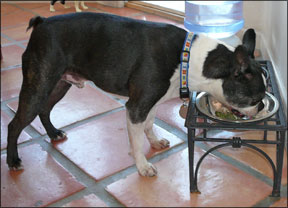
■ 75 to 80 percent animal protein (7½ to 8 oz), consisting of 5½ to 6 oz meat (beef, chicken, turkey, canned salmon, or sardines) and 2 oz yogurt, cottage cheese, kefir, or one egg
■ 5 to 10 percent organ meat, consisting of ½ to 1 oz kidney or liver
■ 15 percent veggies, consisting of 1½ oz broccoli, spinach, cauliflower, sweet potato, zucchini, carrots, dark leafy greens, and/or cabbage
I also give the following supplements to each dog daily:
■ 1 fish oil softgel (EPA 180/DHA 120)
■ ¼ tsp Berte’s Immune Blend, ½ tsp Berte’s Ultra Probiotics, and ½ tablet Berte’s Zyme (digestive enzymes) with each meal
■ 500 mg calcium (¼ tsp dried, ground eggshell). Note that I do not add calcium when feeding canned fish with bones.
I cook, mix, and freeze one to two weeks’ worth of meat, organ meat, and veggies; I add dairy and supplements right before feeding. I puree the veggies in a food processor, and stay away from white potatoes, tomatoes, eggplant, and peppers, as my older girl has arthritis. I have elected to feed no grains or legumes.
When I make up the food, I cook the meat first, then puree the veggies, and then prepare the organ meat (my dogs will not eat raw liver, so I now braise the liver and then puree it in the food processor).
I bought a number of 9½-ounce and 14-ounce stackable plastic containers. I put a container on my kitchen scale and start measuring in the different portions of meat, organs, and veggies until it totals 8 ounces. Most meals will fit in the 9½-ounce containers, but occasionally I use the larger ones for the bulkier chopped-meat meals. Each container has one day’s food for each dog, which I feed half in the morning and half at night. I store food for two days in the fridge and pop the rest in the freezer.

I buy fresh meat (chicken, turkey, beef) and canned salmon at Costco. I buy veggies at Costco as well, usually splitting whatever I get between the dogs and the humans in the house, so one unexpected benefit is that we are eating a greater variety and quantity of vegetables than we have in the past. I get organ meat from my local Stater Brothers, which has a wonderful butcher department. I’ve had trouble finding kidney, so I’m just feeding 5 percent liver right now.
Two dogs had some problems with the diet change, despite my doing a slow transition. One developed loose stools for a few days, but is now doing fine on 100 percent home cooked. The other has always had a sensitive stomach and has had problems with regurgitation. She is still on half kibble/half home cooked while I try to figure out what part of the new diet is not agreeing with her.
In the short time I’ve been doing this, I’ve noticed less gas and firmer stools, and my oldest girl’s skin seems less flaky (she has had dry, flaky skin since she came into rescue last August). They all love the new food (other than the raw liver!) and “dance” for their dinner now. It really is not that difficult; in fact, once I figured it all out and went through the process of doing it, I thought it was too easy and that I must be doing something wrong!
Our comments on Engman’s diet:
Probiotics and digestive enzymes may help prevent digestive problems when switching diets. Probiotics are also helpful for dogs who have been on antibiotics, or have had diarrhea. It’s not necessary to continue to give digestive enzymes unless your dog does better with them added. It’s better to split the calcium dosage and give half with each meal rather than giving it all at once.
Cooking food for big dogs
Brenda and Joe Carriere, of Minneapolis, Minnesota, have been cooking for their two German Shepherds, eight-year-old Sarge and two-year-old Nikki, for about a month due to the recall. Brenda describes her preparations:
I feed a diet that includes both grains and legumes. Here is my basic recipe:
■ 3 lbs meat (ground turkey, beef, or pork; chicken thighs; or jack mackerel and sardines)
■ 6 eggs (scrambled)
■ 1 or 2 cups whole milk cottage cheese or yogurt
■ 6 ounces organ meat (beef liver, pork kidney, chicken hearts, etc.)
■ 2 cups cooked brown rice plus 2 cups veggies (carrots, sweet potatoes, yams, broccoli, peas, spinach, etc.), OR 4 cups legumes (2 cups each green beans and either lentils or pinto beans)
I cook everything separately, on the stove or, in case of the chicken thighs, on the grill. After the thighs are cooked, I take the meat off and throw away the bones. I steam the veggies or cook the sweet potato in the microwave.
I prepare food a few times a week, usually in batches of two or three days, then portion them individually for each dog and store them in the fridge. Everything is mixed together and ready to be served. I feed each dog one and a half to two cups twice a day. I microwave it for 30 seconds to take off the chill, and then add supplements at mealtime.
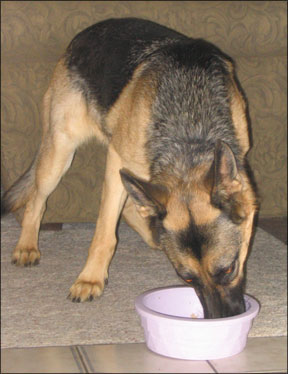
I give each dog 1,000 mg fish oil and 400 IU vitamin E daily, as well as one teaspoon organic apple cider vinegar. When not feeding canned fish, I add one teaspoon crushed eggshell daily. They occasionally get fruit, such as bananas, strawberries, pineapple, and mangos, in addition to their regular diet. They also get recreational femur bones two or three times a week, and I estimate that at least 10 percent of their calories come from training treats, usually chicken or cheese.
We plan to continue home cooking (there may be a dog coup d’état in my house if we go back!). Even in this short time, Sarge’s coat has become glossy with no more dandruff, and he no longer scratches and nibbles at himself. He has also lost a few pounds, something we weren’t able to accomplish while on kibble because he always seemed hungry. Nikki has become enthusiastic about meals, while before I had to coax her to eat. Both dogs love their new diet: every time we go to the fridge or microwave something, they are right there, waiting expectantly for their new food.
Comments: Legumes combined with grains provide more complete protein then either does alone, so it is better to feed them together, rather than alternating them between meals. Legumes (including green beans) should always be cooked due to a toxin they contain when raw (though small amounts would not be harmful).
Using a spreadsheet
Lynn Byrd lives outside Marceline, Missouri. She developed her diets with a spreadsheet to ensure that they meet the canine nutrition guidelines established by the National Research Council (NRC). Byrd has fed the following diet to her dogs for 12 years, because, as she says:
I didn’t like the idea of processed kibble and my Bull Terrier was really gassy. We now have two Bull Terriers: Teddy, three years old, and Triumph, about 11 years old, a deaf rescue who earned her CGC (Canine Good Citizen) using sign language.
We also foster rescues. These dogs are usually in pretty rough shape and I always switch them to homemade diets as soon as they arrive; none of them have had any problems with the switch. One foster dog, Kobe, had terrible mange and deep secondary infections; he was skinny and terribly weak. I doubt he would have made such a complete recovery without his easily digested homemade diet. Another foster, Joe, had terrible teeth when he arrived, but he was also infected with heartworms so the teeth cleaning was put off until the heartworms were treated, and by then his teeth looked great!
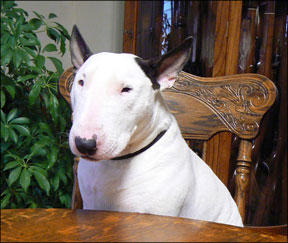
The diet I feed combines raw meat with cooked eggs, veggies, and rice. Here is my basic diet for a 65-pound dog; the amounts here are for a three-day supply.
■ 1 lb ground turkey
■ 1 lb ground beef (80 percent lean)
■ 1 can jack mackerel
■ 4 large eggs
■ 2 oz beef liver
■ 1 cup (uncooked) rice
■ 4 medium potatoes
■ 1 cup/can vegetables (any)
■ 2½ Tbsp NOW bone meal (this provides 3,500 mg calcium)
■ ½ tsp NOW potassium (provides 1,460 mg potassium) optional
■ 2 Tbsp sunflower or safflower oil
For variety, a 24-ounce carton of cottage cheese can be substituted for a can of mackerel or a pound of meat. And of course other meats such as venison, pork, chicken, etc. can be used instead of the beef or turkey.
This recipe makes enough food for three days. It can be frozen in meal size portions. It’s easy to prepare:
1. Cook the rice. Then mix in the oil, potassium, and bone meal.
2. Bake the potatoes and chop them up in their skins.
3. Lightly fry or scramble the eggs.
4. Mix all ingredients and place in a plastic shoe box.
5. Score into six equal portions if feeding twice a day.
To feed the liver, cut it with scissors into several small pieces, freeze, and feed one piece several times a week (it doesn’t do well mixed with the other items, as it goes bad quickly). Give a human One-A-Day-type multi-vitamin/mineral daily (I used One Source Advanced Multivitamin & Mineral from Wal-Mart. It provides 15 mg zinc, 3 mg manganese, and 45 IUs vitamin E used to meet NRC guidelines).
Comments: This diet uses a little less organ meat and a little more carbohydrates than I think is ideal, but it’s still a great diet. Increasing the amount of organ or muscle meat just a little would meet zinc requirements without the use of a supplement.
The diet provides the required minimum amount of potassium without the supplement, but Lynn feels that adding more is preferred based on her nutritional studies.
Note that Joe’s teeth improved even though his diet did not include bones!
Feeding a thin, picky dog
Jennifer Kuhlman, of Colorado Springs, Colorado, began cooking for Echo, her five-year-old male standard Poodle (50 pounds), and Cayenne, her five-year-old female mixed breed (40 pounds), about a month ago. Here is Kuhlman’s home-prepared plan:
Echo has always been quite thin, and a picky eater despite my adding fresh foods to his kibble, while my rescue dog, Cayenne, is a little chubby, and will eat anything! I had considered feeding homemade several times, but the recall pushed me over the edge. I will definitely continue, as I’m really enjoying it.
In the morning, they each get 4 ounces of ground beef, chicken, or turkey, plus 1 to 2 ounces of chicken liver, and the larger dog gets 6 ounces of cottage cheese, the smaller 4 ounces.
I add an egg about once a week; Echo does not love them, but will eat them occasionally.
In the evening, Echo gets 12 ounces of meat (beef, chicken, turkey, or canned jack mackerel), and Cayenne gets only 4 (due to her weight issues). Then they each get about 4 ounces of a variety of cooked veggies (mostly sweet potatoes, steamed broccoli, and canned green beans, but occasionally whatever we are having for dinner), and a quarter cup of brown rice.
I supplement each dog with a teaspoon of Solgar Bone Meal Powder (1,000 mg calcium) and a fish oil capsule daily. Cayenne gets a teaspoon of Berte’s Immune Blend but Echo doesn’t like it, so he gets a vitamin E capsule.
All the meats are lightly cooked, either sautéed, or cooked (in patties) on a George Foreman grill. I try to leave a little pink in the center. I prefer to use free-range, antibiotic-free, and usually organic meat.
I cook four or five day’s worth of meat patties for breakfast, but usually I cook their evening meal right when I serve it, as Echo gets more interested when he knows his dinner is getting cooked. In the beginning, I tried to prepare a week’s worth of meals at once, and he stopped eating it after three days. He is better about eating his breakfast though; he really likes liver and cottage cheese. It’s great to finally see Echo excited by meals, with no need to be coaxed to eat. They are both doing great and I’m having lots of fun cooking for them. Their condition has not changed much in such a short time, but the enjoyment they get from eating has hugely increased.
Comments: It can be a challenge to get a picky dog to eat a proper diet. It’s important not to give in and feed only a few foods. Experiment with different ways of preparing and serving foods in order to learn the tricks that work for your dog, such as Kuhlman has discovered with Echo.
Using a pressure cooker and including bones
Dee Davidson, of Redondo Beach, California, began feeding her 16-month-old, 61-pound Labradoodle a home-cooked diet in early March.
I’m using a pressure cooker for the bony meals and regular pots for the other meat meals. I feed two meals a day, one of meaty bones and one of meat, organs, eggs, dairy, etc. I’ve also started giving my dog a raw meaty bone three days a week to help keep her teeth clean.
I pressure-cook whole chickens, turkey drums, or wings, or meaty pork necks for about an hour, which results in most of the bones becoming crumbly soft. The large turkey leg and wing bones may still be firm in the center, so I crumble the ends and scoop out the marrow of the firm ones, throwing the rest away. I throw out the part of the pork neck bones that are not soft enough to crumble as well. I also cook other meaty beef or pork bones in the pressure cooker, but most of the bones aren’t soft enough to crumble and feed, so I throw out the bones and feed the meat with a half a teaspoon of ground eggshells.
I usually add a cup of either brown rice or barley, along with a can of green beans, a couple of carrots, and leftovers of any other vegetables, plus two chopped cloves of garlic, to the pressure-cooker.
I cook other kinds of meat in a regular pot, including any large cuts of meat, such as those intended for pot roasts, or tongue, heart, and ground meats. I lightly braise liver and boil kidney. Vegetables may be added if the cooking is going to be long enough to make them digestible.
I add a couple of tablespoons of cottage cheese, plain yogurt, or grated cheese four days a week to either her meaty meal, or as an evening snack. I feed one egg scrambled with spinach and cheese four days a week as part of the meaty meal.
I’m giving her about a can of salmon weekly. I give her small amounts in several meaty meals because larger amounts seem to cause a bit of loose stool.
After cooking and cooling, I put the cooked food in 8-ounce portions into sandwich bags. I keep four or five in the refrigerator and put the remainder in the freezer. I have an average-size refrigerator/freezer, but so far this has worked satisfactorily.
I hope this helps someone who is just starting and feels overwhelmed with the process. It’s very easy. With the exception of breads, crackers, and desserts, I’m feeding my dog almost exactly what I feed myself.
My dog loves this new diet. She knows all the signs and sounds of her food being prepared and does her “perfect doggie” routine so I won’t find any excuse to delay feeding her! After three months on the new diet, I took her to a new vet last week and his first comments were, “I’ve seen other Labradoodles, but she definitely looks the best of them all. She’s in perfect health.”
Comments: Remember that when you feed cooked bones, they must be completely soft, and you must be sure there is plenty of meat or other foods added, as otherwise the cooked bone can cause constipation or even impaction.
Cooking for a puppy and an adult dog
Pam Richard, of Portsmouth, New Hampshire, cooks a diet for her two Eurasiers: two-year-old Ruq and five-month-old Tika. She’s been cooking for her older dog for about a year and a half, after losing a dog to gastrointestinal cancer and starting to wonder if nutrition might have been a factor. She was hesitant to feed her puppy a homemade diet, but when the recalls started, she decided to jump in:

The “big dog” (55 pounds) gets about 9 ounces of protein per meal (this varies between chicken, turkey, beef, pork, eggs, and fish, mixed with liver and/or kidney), plus calcium (¼ teaspoon ground eggshell). She gets a vitamin (Thorne Basic Canine Nutrients) and salmon oil with both meals. In the morning, I give her one spoonful each of canned tripe and yogurt with the protein. In the evenings, I add about 3 ounces of veggie mix: sweet potato or carrot, various “above ground” veggies, and herbs (alternating between mint, parsley, and dill). I recently stopped adding grains on a regular basis but previously used brown rice, oatmeal, and pearled barley.
The puppy gets three meals a day, of 6 ounces each. I am slowly adding the same variety of protein sources, along with tripe and yogurt one meal, a tablespoon or so of the veggie mix one meal, and a spoonful of grains one meal. I split a teaspoon of Solid Gold Bonemeal between the three meals. I also supplement with Berte’s Daily Blend and salmon oil at two meals.
The meat is usually boiled, sometimes roasted, then chopped up and frozen in portions that last a couple of days.
Once I really got into home cooking, I bought a chest freezer that has been wonderful both for freezing the cooked food and storing pre-cooked meat. I cook sweet potatoes in the microwave for five minutes, while some of the other veggies are cooked (steamed), and then all are chopped up fine in a food processor. I keep the meat and veggies separate so I can mix and match per meal/dog.
Tika, my puppy, was a slow eater with kibble and needed encouragement to finish. Now she is eager to eat and gobbles it all down! I think that my pup’s eyes look much clearer and brighter after changing from kibble, and I was using high-quality brands. Both dogs just look overall healthy to me, and they certainly eat with great gusto!
Comments: The amount of calcium added to a puppy’s diet is very important. The teaspoon of bone meal that Pam adds supplies 1,368 mg of calcium to balance out 18 ounces of food, so that’s around 1,200 mg of calcium per pound of food. The vitamin supplement she uses contains vitamin D, which enhances the uptake of calcium, so this amount looks just about right.
Help for food intolerances
Sally Gutierrez, of Long Beach, California, has been feeding a homemade diet to her dogs, who have many food intolerances, for almost two years. She started feeding a home-prepared diet when her 15-year-old Dachshund was diagnosed with pancreatitis. He lived another 18 months – well past his veterinarian’s prediction – and the improvements in his health helped him enjoy a good quality of life in his final months. That experience led Gutierrez to home-prepare all of her dogs’ food.

Currently, I have two rescue dogs: Smokey, a 7-year-old Chow/Lab, and CC, a 13-year-old Eskimo/Lab. Smokey gets 16 ounces of food twice a day, and CC gets 14 ounces twice a day.
Typically their meals consist of slow-cooked meat (e.g., pork, turkey, chicken, or beef, cooked in a crockpot for about 12 hours), or Evanger’s canned Game Meats (duck, pheasant, buffalo, rabbit), or canned fish with bones, such as pink salmon and sardines. I try to give them the fish once a week, and rotate the meats as much as possible. Smokey has one poached egg with his food every day. I don’t give CC an egg because, for her, it triggers diarrhea.
Along with the meat I give them about 40 to 50 percent vegetables. I feed a wide variety of veggies: creamed winter squash (their favorite! – I buy it frozen and already cooked and creamed, I just heat it in a microwave), summer squash, broccoli, cauliflower, green beans, peas, carrots, and occasionally spinach and cucumber.
I usually buy the veggies frozen and nuke them till they are barely warm (to retain most of the nutrients). I then blend them with a meat broth left over from the slow-cooked meat. Occasionally I grate fresh produce and add it to a broth soup.
The only organ meat that they get is beef liver (organic or grass-fed), usually small amounts for about five days, every other week. I give them small amounts to limit the vitamin A that is found in liver. On occasion, I add variety, such as beef marrow gut, chicken hearts, and chicken gizzards. I would like to add more organ meats but have a hard time finding them.
I originally added rice to their meals but discovered that it gave them both diarrhea. I tried wild rice and Minute rice and had the same results. They both appear to be lactose-intolerant, so they get no dairy products.
I provide them a vitamin supplement (rotating between brands) and also add ½ teaspoon Kal Bone Meal Powder per meal. I recently began wrapping their vitamins in a blob of nut butter – it serves as a sneaky treat!
Their diets are almost identical to my diet (I have severe food allergies). CC has several food allergies and may have undiagnosed inflammatory bowel disease (IBD). I have seen about a 95 percent reduction in scratching from my dogs since starting to feed them a homemade diet. CC’s formerly watery stools are now firm, and her stiffness and muscle weakness in the rear are now gone as well.
Comments: The amount of food these dogs are fed may seem like a lot, but almost half of it is vegetables, which are lower in calories. Both dogs are also quite active, going on hikes in the mountains with their owner regularly. The amount of bone meal in this diet is high, and Gutierrez plans to adjust the amount to provide around 1,000 mg of calcium per pound of food.
A low-fat diet for a dog with health problems
Janet Hughes, of Greenbelt, Maryland, has been feeding a low-fat cooked diet for the past 18 months to her elderly Collie-mix, who suffers from chronic pancreatitis.
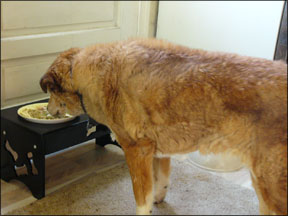
Scampers is 18 years old and weighs 50 pounds. Here is her typical daily diet, split between breakfast and supper:
■ 1 cup chicken breast, boiled, with all visible fat removed
■ ¼ cup heart (usually beef, occasionally turkey or chicken), boiled, fat removed
■ ¼ cup lean ground meat (beef, pork, or turkey), boiled and rinsed; beef kidney; or chicken gizzards
■ ¼ cup liver (pork, chicken, or beef)
■ ¼ cup cottage cheese, nonfat or low fat
■ ½ cup boiled veggies (approximately one part summer squash to one part collard or turnip greens, kale, Brussels sprouts, broccoli, or spinach)
■ ½ cup starchy carb (sweet potato, oatmeal, or barley)
■ 1½ Tbsp coconut oil
■ ½ tsp ground eggshell
She also gets lunch, which is a scrambled egg with yogurt, or occasionally jack mackerel (she can’t tolerate much of it, and doesn’t care for whitefish).
I supplement daily with two or three fish oil softgels, Berte’s Digestion Blend, and a geriatric vitamin tablet (Geri-Form), along with 400 IUs vitamin E three or four times a week. She also gets medications for pancreatic insufficiency and arthritis.
I cook, package, and freeze about once a month, using an assembly-line production over a few days. I boil the veggies all at once, then cook the starchy carbs. I package the half-and-half mixture of the two with the coconut oil and eggshell so that her eggshell and coconut oil for one day are in one cup of the veggie/starch mix. I then boil the chicken, cool and chop, then boil the heart and cut it into cubes. I cook the ground meat or gizzard, then the liver, and cube them.
I package each day’s ration into a single GladWare container, stacking chicken, other meat, liver, and cottage cheese, with the veggie mix on top.
I’ve tweaked her diet over several months to suit her. Too much broccoli or too little summer squash in her veggie mix and she gets burpy and spits up, for example. She doesn’t care for white potato, and lamb is too fatty for her.
I found the addition of the Digestion Blend keeps her settled. Prior to starting that, she’d have almost monthly flare-ups of inappetence and diarrhea. The coconut oil also was a major boon for maintaining overall bounce. She’s been eating this home-cooked diet for over 18 months (after a couple of years of trying to resume a normal diet, then trying Hill’s and IVD prescription diets, which she hated).
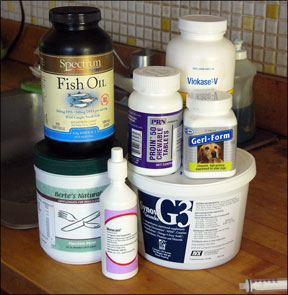
Comments: This is a great example of how a homemade diet can be modified to meet an individual dog’s needs. Whether specific ingredients need to be avoided, fat levels need to be adjusted, or ratios need to be tweaked, you have complete control and can feed what works for your individual dog. Coconut oil supplies a form of fat that is more easily digested by dogs with fat intolerances.
Just share your own meals
Carol Boyle, of the greater New York City metropolitan area, has cooked for her Great Pyrenees for more than two decades!
I started with Pitcairn (Dr. Pitcairn’s Complete Guide to Natural Health for Dogs & Cats) as my guide, but thought he did not use as much variety as I would like to use, so I began adding more and different vegetables. I realized that I would make chicken thighs for the dogs one night, and then roast breasts the next night for my family, and the light went on. I began cooking whole chickens and we share them.
When I cook for my husband and myself, we always start with a salad, followed by a protein source, a vegetable, and a carbohydrate. I serve the same or similar foods to the dogs. I cook as though I am cooking for a large family.
Sunday was a typical meal. I put two 5-pound chickens in the oven to roast. They were lightly sprinkled with garlic salt and lots of dried rosemary. I made rice pilaf and broccoli. The dogs got the giblets (liver and heart, etc.) of the chickens, as well as the dark meat. We ate the breast. We had a salad and the dogs got some shredded carrots and cucumbers in with their food too. There is one chicken and some rice left for another meal for them.
Last night we had London Broil, baked potato, cauliflower, and some salad.
Sharing meals has taken the drudgery out of feeding something special to the dogs. Basically, we all eat the same food. The dogs get a higher percentage of meat (⅔ meat to ⅓ veggie and carbo combo) than we do, and they do get some meals that are different from ours. Three times a month they get liver; once a week they get canned salmon or sardines. We go out or call out for dinner when they get the different foods (neither of the dogs like Chinese food, but pizza is another story!).
The dogs have done remarkably well on this diet. My old Patou was five years old when I started this diet, and he lived to be almost 15, an unheard-of age for a Great Pyrenees. Our current crew consists of Cajun, 11 years, and my new Patou, three years. I make certain that everything is as fresh and wholesome as possible. We eat all different kinds of meats and vegetables, cooked simply and seasoned liberally with herbs and spices (not hot). And that’s it: 20 years and three dogs. And lots of roasted chicken, steaks, pork roasts, and all kinds of vegetables. The only supplement I give routinely is calcium in the form of eggshells (½ teaspoon ground eggshell per pound of meat). I believe that most of the nutrients we need are best supplied in the variety from a natural diet.
Comments: Dogs don’t digest vegetables very well unless they are either cooked or pureed, to break down the cell walls (grating isn’t enough), though whole, raw veggies will do no harm (they just won’t contribute their full nutritional value). I would feed liver more often than this, simply because it is so nutritionally dense, though you can see that dogs can thrive with less. Oh, and don’t assume your dogs won’t like something like Chinese food – mine have always loved it!
Using pre-mixes
Dawn Lange, of Duluth, Minnesota, feeds commercial dog food pre-mixes to her senior Sheltie and four-month-old miniature Poodle, Spike.
Lange describes her protocol:
I have fed a mixture of homemade and pre-mixes to my older dog for several years. I currently rotate between The Honest Kitchen Embark (which is approved for all life stages) and Urban Wolf with their Dietary Balancer for Puppies added. I occasionally mix in some Innova EVO dry and use that as training treats. I add ground beef, turkey, or chicken, and rotate oils, using peanut, olive, canola, sunflower, etc. I have a grinder so I do use organ meat occasionally and usually grind chicken myself or just use chunks. I cook the meat, as that is what I am comfortable with. I add salmon oil caps to each meal.
I don’t like the idea of using kibble exclusively, but when I got my pup, everyone kept telling me not to risk doing homemade and to use a puppy kibble for the first year. That just seemed wrong. How could it be better than fresh food? I chose to use pre-mixes as a safe compromise.
I am happy with my dogs’ coats and their enthusiasm at mealtime. My vet is happy because the pre-mixes meet AAFCO standards and that makes me feel more comfortable, too.
Comments: Pre-mixes can offer peace of mind for those who worry about the completeness of a home-prepared diet for puppies. Like Lange, be sure to use only those that are specifically formulated for puppies or for “all life stages” according to AAFCO guidelines.
Remember that the right diet for your dog is the one that he does well on, and that you are comfortable with. Each dog is an individual, so what works for one may not work for another. If your dog has problems with what you feed – if he doesn’t enjoy his food, or shows signs of digestive upset – then try something else. Just make sure you’re feeding a variety of different foods, not just his “favorites.” The beauty of a homemade diet is that you can change any part of it to fit your dog’s needs.
Mary Straus does research on canine health and nutrition topics as an avocation. She is the owner of the DogAware.com website. She lives in the San Francisco Bay Area with her 15-year-old dog, Piglet.






I just purchased Home Cooking for a Healthy Dog by Jonna Anne with Mary Straus. I made Farmers Basket to start. Oh my goodness my 3 dogs just loved it ( I have a small, medium and large dog). I didn’t realize my dogs were restless before. They are so satisfied and calm. I supplement with all-in-one , Missing Link Calcium citrate and pro-Zyme
I give them dry dog food for breakfast. They get their homemade in evening. It’s expensive for me but so rewarding to see them so happy.